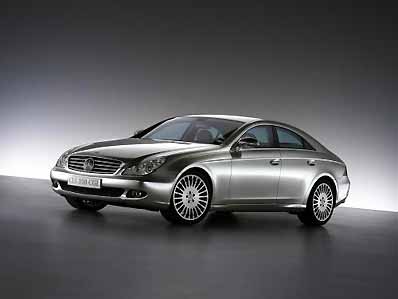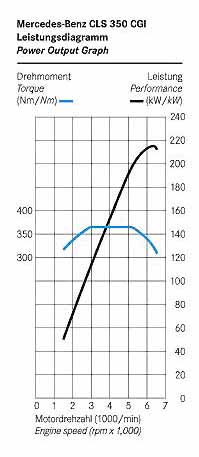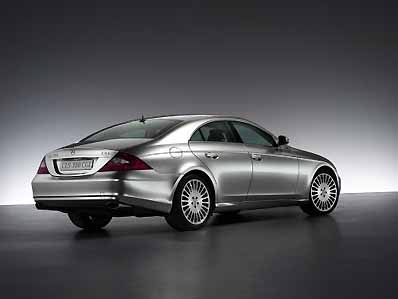
The
Stuttgart-based brand
CLS-CLASS
Effortless performance twinned with excellent fuel
economy

CLS-KLASSE
Gute Kombination: Souveränes Fahr-Erlebnis bei höchster
Wirtschaftlichkeit |
World premiere of an innovative direct petrol
injection system
Stuttgart - Following
intensive development work, Mercedes-Benz is now presenting the world's first
petrol engine with piezoelectric direct injection and spray-guided combustion.
 This 215 kW/292 hp six-cylinder engine
will enter the market in the second half of 2006 in the CLS-Class. In the
European driving cycle, this innovative injection technology from Mercedes-Benz
achieves fuel consumption improvements of ten percent over the highly efficient
V6 petrol engine with port injection and fully variable valve timing: the
figures for the CLS 350 CGI are 9.1 litres per 100 km. Thus Mercedes-Benz
has succeeded in combining a substantial increase in output with a significant
increase in fuel economy. This pioneering injection system is another
trend-setting technology from Mercedes-Benz. It achieves much better fuel
efficiency, and thus also higher thermodynamic efficiency, than conventional
wall-guided direct injection systems. The new system will form the basis
for future engine development work in this output class. The main advantage
of the CGI engine (CGI = Stratified-Charged Gasoline Injection) lies in the
stratified operating mode from which it takes its name. During this mode
the engine is run with high excess air and thus excellent fuel efficiency.
Now, thanks to multiple injection, it is for the first time possible to extend
this lean-burn operating mode to higher rpm and load ranges too. During each
compression stroke, a series of injections takes place, spaced just fractions
of a second apart. This has the effect of significantly improving mixture
formation, combustion and fuel consumption. While stratified charge operation
was previously only possible in the low part-load range, the new Mercedes
direct-injection engine can still operate in this lean-burn stratified mode
at speeds in excess of 120 km/h. When driving on main roads and motorways
at largely constant speed and with proper anticipation, the CGI engine
outperforms the fuel economy of the six-cylinder engine with conventional
injection technology by up to 1.5 litres per 100 km, a saving of up to 15
percent. This 215 kW/292 hp six-cylinder engine
will enter the market in the second half of 2006 in the CLS-Class. In the
European driving cycle, this innovative injection technology from Mercedes-Benz
achieves fuel consumption improvements of ten percent over the highly efficient
V6 petrol engine with port injection and fully variable valve timing: the
figures for the CLS 350 CGI are 9.1 litres per 100 km. Thus Mercedes-Benz
has succeeded in combining a substantial increase in output with a significant
increase in fuel economy. This pioneering injection system is another
trend-setting technology from Mercedes-Benz. It achieves much better fuel
efficiency, and thus also higher thermodynamic efficiency, than conventional
wall-guided direct injection systems. The new system will form the basis
for future engine development work in this output class. The main advantage
of the CGI engine (CGI = Stratified-Charged Gasoline Injection) lies in the
stratified operating mode from which it takes its name. During this mode
the engine is run with high excess air and thus excellent fuel efficiency.
Now, thanks to multiple injection, it is for the first time possible to extend
this lean-burn operating mode to higher rpm and load ranges too. During each
compression stroke, a series of injections takes place, spaced just fractions
of a second apart. This has the effect of significantly improving mixture
formation, combustion and fuel consumption. While stratified charge operation
was previously only possible in the low part-load range, the new Mercedes
direct-injection engine can still operate in this lean-burn stratified mode
at speeds in excess of 120 km/h. When driving on main roads and motorways
at largely constant speed and with proper anticipation, the CGI engine
outperforms the fuel economy of the six-cylinder engine with conventional
injection technology by up to 1.5 litres per 100 km, a saving of up to 15
percent.
Effortless performance twinned with
excellent fuel economy
 Low fuel consumption and excellent power delivery
are not at odds with each other on the second-generation Mercedes-Benz direct
petrol injection model. On the contrary, the engine delivers 15 kW/20 hp
more power than the conventional-injection V6 and four percent more torque.
Thus the V6 combines its excellent fuel economy with a level of effortless
driving enjoyment that is unprecedented in the six-cylinder segment. The
CLS 350 CGI accelerates from 0 - 100 km/h in just 6.7 seconds and has an
electronically gov-erned top speed of 250 km/h. The key figures for the new
CGI engine are: Low fuel consumption and excellent power delivery
are not at odds with each other on the second-generation Mercedes-Benz direct
petrol injection model. On the contrary, the engine delivers 15 kW/20 hp
more power than the conventional-injection V6 and four percent more torque.
Thus the V6 combines its excellent fuel economy with a level of effortless
driving enjoyment that is unprecedented in the six-cylinder segment. The
CLS 350 CGI accelerates from 0 - 100 km/h in just 6.7 seconds and has an
electronically gov-erned top speed of 250 km/h. The key figures for the new
CGI engine are:
• Displacement 3498 cc
• Compression ratio 12.2:1
• Rated output 215 kW/292 hp at 6400 rpm
• Rated torque 365 Newton metres at 3000-5100 rpm
With a fuel consumption of 9.1 - 9.3 litres per 100 kilometres (NEDC combined
cycle), the four-door Coupé has a range of approximately 870 kilometres
on one tank filling (80 litres). |
Pioneering invention: outward-opening
piezoelectric injectors
The most important components of this innovative direct petrol injection
system are the fast-acting, high-precision piezoelectric injectors. It is
on this invention and the way it has been translated into series-production
technology that the most important advances associated with spray-guided
combustion are based. The piezoelectric valves have injectors which open
outwards to create an annular gap just a few microns wide. This gap shapes
the fuel jet and produces a uniform, hollow-cone-shaped spray pattern. The
microsecond response times of the piezoelectric injectors provide the basis
for delivering multiple injections per compression stroke, and thus for lean-burn
operation. By allowing flexible and efficient control of the combustion process
they play a key part in ensuring the engine's outstanding fuel efficiency.
With the aid of simulations for the fuel mixture and the combustion process,
the pistons have been designed with special piston bowl geometry which
concentrates the lean mixture in the area around the spark plug and prevents
it from spreading out towards the cylinder wall. The piston shape therefore
also plays its part in en-suring near-total combustion, low fuel consumption
and low emissions in the direct-injection petrol engine. A high-pressure
pump and downstream fuel rail and pressure control valve are responsible
for delivering the fuel and regulating the quantity supplied. The peak fuel
pressure in this system is up to 200 bar - around 50 times the fuel pressure
in a conventional petrol injection system.
Dual effect: low engine-out emissions
and high exhaust temperatures
 The Mercedes-developed combustion process
featuring multiple closely spaced in-jections on each compression stroke
also results in smoother operation and improved emissions performance.
Measurements show that engine-out hydrocarbon emis-sions in the warm-up phase
are almost halved. Furthermore, since the injection and combustion processes
can be actively controlled, it is also possible to raise temperatures in
the exhaust manifold and thus speed catalytic converter warm-up. Just ten
seconds after starting from cold, the direct-injection petrol engine reaches
an exhaust temperature of over 700 degrees Celsius. Emissions are controlled
by two close-coupled three-way catalytic converters with linear oxygen sensor
control, which goes into operation immediately after the en-gine starts from
cold. To reduce nitrogen oxide emissions, Mercedes-Benz has adopted a two-part
strategy. This comprises, firstly, dual electrically controlled and cooled
exhaust gas recirculation which, depending on engine operating conditions,
redirects up to 40 percent of the exhaust gases back into the cylinders.
Secondly, it also comprises two underfloor NOx storage-type catalytic converters.
Under lean operating conditions, these converters adsorb the nitrogen oxides.
Periodically, during brief regeneration pulses, the nitrogen oxides are then
desorbed, reacting with other exhaust gas constituents to form harmless nitrogen.
Sensors upstream and down-stream of the catalytic converters monitor their
operation. In addition, the new CGI engine also incorporates the same unique
package of high-tech features as its conventional-injection counterpart.
This includes four-valve cylinder heads, variable intake and exhaust camshaft
timing, a two-stage in-take manifold, balancer shafts and intelligent thermal
management with an electronically controlled thermostat. The crankcase and
cylinder heads are of alumin-ium and the cylinder liners are of low-friction,
thermally resistant, lightweight aluminium-silicon alloy. All fuel-carrying
components of the CGI engine are of high-grade steel or brass; the rails
in the area of the two cylinder banks and the housing of the high-pressure
pump are of forged stainless steel. The new CLS 350 CGI is designed to operate
on sulphur-free unleaded premium fuel and its state-of-the-art technology
gives it the potential to adapt to emissions standards of the future. The Mercedes-developed combustion process
featuring multiple closely spaced in-jections on each compression stroke
also results in smoother operation and improved emissions performance.
Measurements show that engine-out hydrocarbon emis-sions in the warm-up phase
are almost halved. Furthermore, since the injection and combustion processes
can be actively controlled, it is also possible to raise temperatures in
the exhaust manifold and thus speed catalytic converter warm-up. Just ten
seconds after starting from cold, the direct-injection petrol engine reaches
an exhaust temperature of over 700 degrees Celsius. Emissions are controlled
by two close-coupled three-way catalytic converters with linear oxygen sensor
control, which goes into operation immediately after the en-gine starts from
cold. To reduce nitrogen oxide emissions, Mercedes-Benz has adopted a two-part
strategy. This comprises, firstly, dual electrically controlled and cooled
exhaust gas recirculation which, depending on engine operating conditions,
redirects up to 40 percent of the exhaust gases back into the cylinders.
Secondly, it also comprises two underfloor NOx storage-type catalytic converters.
Under lean operating conditions, these converters adsorb the nitrogen oxides.
Periodically, during brief regeneration pulses, the nitrogen oxides are then
desorbed, reacting with other exhaust gas constituents to form harmless nitrogen.
Sensors upstream and down-stream of the catalytic converters monitor their
operation. In addition, the new CGI engine also incorporates the same unique
package of high-tech features as its conventional-injection counterpart.
This includes four-valve cylinder heads, variable intake and exhaust camshaft
timing, a two-stage in-take manifold, balancer shafts and intelligent thermal
management with an electronically controlled thermostat. The crankcase and
cylinder heads are of alumin-ium and the cylinder liners are of low-friction,
thermally resistant, lightweight aluminium-silicon alloy. All fuel-carrying
components of the CGI engine are of high-grade steel or brass; the rails
in the area of the two cylinder banks and the housing of the high-pressure
pump are of forged stainless steel. The new CLS 350 CGI is designed to operate
on sulphur-free unleaded premium fuel and its state-of-the-art technology
gives it the potential to adapt to emissions standards of the future.
In Western Europe, the CLS direct petrol injection model will replace the
current CLS 350.
| DaimlerChrysler Communications,
Stuttgart (Germany), Auburn Hills (USA), March 2006 |
BACK TO TOP |
